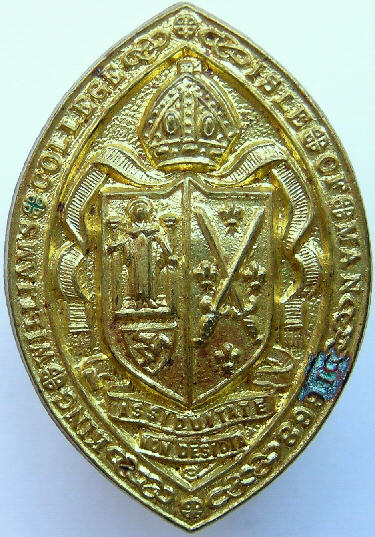King William’s College Tokens
King William’s College

King Williams College is an independent school, situated near Castletown. The College was founded with financing from the Bishop Barrow Trust originally set up in 1668 to fund education in the Isle of Man, but was eventually used to found the college in 1833, which opened with only 46 boys. The coat of arms in the centre of the College’s crest is that of Bishop Isaac Barrow. The school is named after King William IV who is said to have offered the founders, "my most valuable possession, my name" when asked for a financial contribution.
Since 1904, the College has set an annual general knowledge test, known as the General Knowledge Paper. The pupils sit the test twice, once unseen on the day before the Christmas holidays, and again when they return to school in the new Year, after having spent the holiday researching the answers. It is well known to be highly difficult, a common score being just two correct answers from a list of several hundred. The quiz is popular with non-pupils and has been published in the Guardian since 1951.
The College has a proud military history – its Officer’s Training Corps (OTC), established in 1911 saw active service in the Great war. 546 members of the College Community served in the First World War. The OTC cap badge is shown here.

The OTC unit later evolved into the Junior Training Corps about ayear before the Second World War. 696 members of the College Community served in the Second World War. In 1948 the Combined Cadet Force was established as the Junior Training Corps was integrated with the Air Training Corps and Sea Cadet Corps at the College.
Three old boys have won the V.C. The most recent being Major Robert Henry Cain at the Battle of Arnhem in 1944. To celebrate the 150th anniversary of the Victoria Cross in 2006, there was a very interesting programme about how Major Cain won his V.C. Narrated by Jeremy Clarkson, – and at the end he said that Major Cain, who died in 1974 aged 64, was his father in law.
The College issued tokens for use in the school tuck shop. Their period of use was from 1937-1952, and they were issued by housemasters weekly as part of pocket money which could be used in the school tuck shop. It is not known how many were minted or the manufacturer, there were approximately 200 boys at this time, so it must have been a considerable number. It’s official name was "tuck shop money", although it was known by the boys as "phoney dough". The main reason for their introduction was to prevent boys spending their money at places other than the school tuck shop. The idea was that any profits should be routed back for the boys’ benefit. The money was used to purchase items such as radios and a sound projector for Saturday evening films.



There are three denominations, a halfpenny in copper, a penny in brass and a sixpence in aluminium. They are all the same design, showing K.W.C. on the obverse and the denomination within a wreath of oak leaves and acorns on the reverse. They are all 26mm in diameter and for some reason the halfpenny is much rarer than the other two denominations.
The College issued prize medals for various sporting events –


Silver medal (44mm), arms of college engraved on the obv. Rev. is engraved BOXING/1920/LIGHTWEIGHTS/WON BY/A. WEALE. All within a laurel wreath and signed VAUGHTON BIRM.


Bronze medal (40mm), arms of college on the obv. Rev. is engraved STEEPLECHASE/UNDER 15/SECOND PRIZE/ WON BY, and is not named. Similar medals are known in silver.


Bronze medal (34mm), arms of college on the obv. Rev. has ATHLETIC · SPORTS around above and laurel wreath around below, with Won by across centre and is engraved; HIGH JUMP UNDER 13. H.A.R. GARRETT. This medal is also known in the larger (40mm) size and may exist in silver.
In 2008 the College celebrated its 175th anniversary and this medal was struck by the Pobjoy Mint to celebrate that occasion. It is cupro-nickel and is blank on the reverse.

Alan Cope
